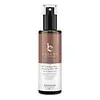What's inside
What's inside
 Key Ingredients
Key Ingredients

 Benefits
Benefits

 Concerns
Concerns

 Ingredients Side-by-side
Ingredients Side-by-side

Aloe Barbadensis Leaf Juice
Skin ConditioningDihydroxyacetone
Skin ConditioningHyaluronic Acid
HumectantGlycerin
HumectantVitis Vinifera Seed Extract
AntimicrobialHamamelis Virginiana Extract
AntiseborrhoeicCamellia Sinensis Flower Extract
PerfumingCucumis Sativus Fruit Extract
EmollientPunica Granatum Extract
AstringentRosmarinus Officinalis Extract
AntimicrobialChamomilla Recutita Flower Extract
MaskingCalendula Officinalis Flower Extract
MaskingCitrus Sinensis Peel Oil Expressed
PerfumingCitrus Grandis Peel Oil
MaskingMentha Piperita Oil
MaskingLeuconostoc/Radish Root Ferment Filtrate
AntimicrobialLactic Acid
BufferingAloe Barbadensis Leaf Juice, Dihydroxyacetone, Hyaluronic Acid, Glycerin, Vitis Vinifera Seed Extract, Hamamelis Virginiana Extract, Camellia Sinensis Flower Extract, Cucumis Sativus Fruit Extract, Punica Granatum Extract, Rosmarinus Officinalis Extract, Chamomilla Recutita Flower Extract, Calendula Officinalis Flower Extract, Citrus Sinensis Peel Oil Expressed, Citrus Grandis Peel Oil, Mentha Piperita Oil, Leuconostoc/Radish Root Ferment Filtrate, Lactic Acid
Water
Skin ConditioningPropanediol
SolventDihydroxyacetone
Skin ConditioningGlycerin
HumectantAloe Barbadensis Leaf Juice Powder
Skin ConditioningHeptyl Undecylenate
EmollientArgania Spinosa Kernel Oil
EmollientArgan Oil Polyglyceryl-6 Esters
EmollientCentella Asiatica Meristem Cell Culture
AntioxidantHydrolyzed Algin
Caprylic/Capric Glycerides Polyglyceryl-10 Esters
EmollientSodium Hyaluronate
HumectantChlorella Vulgaris Extract
Skin ConditioningHibiscus Sabdariffa Flower Extract
Skin ConditioningChamomilla Recutita Flower Extract
MaskingAscorbyl Palmitate
AntioxidantVitis Vinifera Seed Oil
EmollientCitrus Aurantium Bergamia Fruit Oil
MaskingCetearyl Glucoside
EmulsifyingAlcohol Denat.
AntimicrobialMaris Aqua
HumectantPolyglyceryl-4 Caprate
EmulsifyingCyamopsis Tetragonoloba Gum
Emulsion StabilisingXanthan Gum
EmulsifyingParfum
MaskingGluconolactone
Skin ConditioningPotassium Sorbate
PreservativeSodium Benzoate
MaskingWater, Propanediol, Dihydroxyacetone, Glycerin, Aloe Barbadensis Leaf Juice Powder, Heptyl Undecylenate, Argania Spinosa Kernel Oil, Argan Oil Polyglyceryl-6 Esters, Centella Asiatica Meristem Cell Culture, Hydrolyzed Algin, Caprylic/Capric Glycerides Polyglyceryl-10 Esters, Sodium Hyaluronate, Chlorella Vulgaris Extract, Hibiscus Sabdariffa Flower Extract, Chamomilla Recutita Flower Extract, Ascorbyl Palmitate, Vitis Vinifera Seed Oil, Citrus Aurantium Bergamia Fruit Oil, Cetearyl Glucoside, Alcohol Denat., Maris Aqua, Polyglyceryl-4 Caprate, Cyamopsis Tetragonoloba Gum, Xanthan Gum, Parfum, Gluconolactone, Potassium Sorbate, Sodium Benzoate
Ingredients Explained
These ingredients are found in both products.
Ingredients higher up in an ingredient list are typically present in a larger amount.
Chamomilla Recutita Flower Extract comes from the Chamomile flower.
Chamomile is rich in antioxidants and has anti-inflammatory properties. Several compounds found in chamomile help with soothing, such as bisbolol.
Antioxidant components in chamomile make it an effective ingredient to help slow the signs of aging. Antioxidants help fight free-radical molecules, or molecules that may damage your skin.
Essential oils from chamomile have been found to improve wound healing due to its antimicrobial properties.
Ancient Greeks and Egyptians used Chamomile to treat skin redness and dryness. Chamomile has also been used to help treat stomach issues.
Learn more about Chamomilla Recutita Flower ExtractDihydroxyacetone, or DHA, is a simple sugar. It is frequently used in self-tanning products.
DHA binds to the amino acids in your dead skin cells to create a brown/orange color. Darkening begins to kick in a few hours after application and will continue to develop for up to 3 days. This ingredient can be drying.
Both the US and the EU have approved DHA in self-tanning products. In the EU, DHA is allowed at a maximum concentration of 10%. Most tanning products usually contain amounts between 3-5%.
If you are pregnant or have underlying medical conditions, it is best to speak with a dermatologist about using self-tanning products.
Learn more about DihydroxyacetoneGlycerin is already naturally found in your skin. It helps moisturize and protect your skin.
A study from 2016 found glycerin to be more effective as a humectant than AHAs and hyaluronic acid.
As a humectant, it helps the skin stay hydrated by pulling moisture to your skin. The low molecular weight of glycerin allows it to pull moisture into the deeper layers of your skin.
Hydrated skin improves your skin barrier; Your skin barrier helps protect against irritants and bacteria.
Glycerin has also been found to have antimicrobial and antiviral properties. Due to these properties, glycerin is often used in wound and burn treatments.
In cosmetics, glycerin is usually derived from plants such as soybean or palm. However, it can also be sourced from animals, such as tallow or animal fat.
This ingredient is organic, colorless, odorless, and non-toxic.
Glycerin is the name for this ingredient in American English. British English uses Glycerol/Glycerine.
Learn more about Glycerin